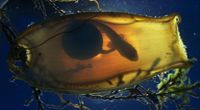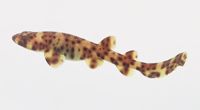Quck answer
Shark pups are born from eggs laid by the mother shark. However, some species of sharks give birth to live young. The gestation period varies from species to species, ranging from a few months to over a year. Some female sharks may give birth to hundreds of pups at a time, while others have smaller litters. The pups are usually born fully developed and able to swim on their own. However, they are still vulnerable to predators and must fend for themselves from the moment they are born.
Wild Animals
Shark Cannibalism and Early Life

David Doubliet/National Geographic/Getty Images
Shark pups that are ovoviviparous rely on the yolk for nutrition. Once the embryo has depleted its own yolk sac, it turns to the surrounding eggs for sustenance. Intrauterine cannibalism is practiced by some species, where the fertilized or unfertilized eggs in the womb are consumed.
The sand tiger shark is the most well-known species that practices intrauterine cannibalism. Despite having two uteri and producing many eggs, each litter only results in two pups – one from each uterus. This is because as the sharks develop embryonic teeth, they begin to feed on the other embryos, killing their unborn siblings and the unfertilized eggs. This is a survival of the fittest scenario in the womb, until only one shark pup remains. As a result of their diet before birth, sand tiger shark pups are larger than other pups, measuring around three feet (one meter) in length [source: National Aquarium].
The sand tiger shark’s cannibalism is called adelphophagy, which means “eating one’s brother” [source: Martin]. Other sharks also practice cannibalism, but in a more subdued form known as oophagy, which is the consumption of unfertilized eggs. Approximately 14 shark species are believed to practice some form of intrauterine cannibalism [source: Martin].

Frank Greenaway/Dorling Kindersley/Getty Images
The swell shark as an embryo…and as a two-month-old pup.В
The number of shark pups varies among species; sand tiger sharks give birth to one or two pups, while viviparous blue sharks can produce up to 134 pups in a single litter [source: Cooper]. The whale shark has given birth to 300 pups, but this is rare [sources: Conrath, Greven]. Regardless of whether they hatch from an egg or are born live, shark pups emerge as small versions of the sharks they will eventually become.
Shark pups are self-sufficient and swim away from their mothers as soon as they are born, possibly to avoid being eaten. Even the smallest sharks face the world alone. Shark pups do not receive any further sustenance or support from their parents; it is up to the pup to find food and evade predators.
A shark pup’s success in life is primarily determined by its size at birth and if the female shark has used a nursery area, which is a shallow region of the sea with fewer predators than the open sea. Certain shark species grow slowly, putting them at risk of being eaten by larger sharks for longer. If few shark pups survive to adulthood and reproduce, shark species could be in danger, especially those that are subject to other pressures like fishing.
Scientists continue to research how shark pups come into the world. Knowing which species have infrequent mating periods, extended gestation periods, low litter counts, or slow growth will assist conservation and protection efforts.
At present, researchers are in the process of creating a fake shark uterus. The sand tiger shark is facing extinction due to a combination of overfishing and a low birth rate. The objective is to replicate the conditions of a real womb by taking pregnant sand tiger sharks, extracting the embryos, and placing them in artificial wombs for the duration of gestation. Ultimately, the baby sharks will be returned to their natural habitat once they have matured [source: Bartlett].
FAQ
1. What is the gestation period for shark pups?
Shark pups can have varying gestation periods depending on the species. Some species, like the great white shark, have a gestation period of up to 18 months. Other species, like the blacktip shark, have a gestation period of around 10 months. During this time, the shark pups develop inside the mother’s uterus.
2. Do all sharks give birth to live young?
No, not all sharks give birth to live young. Some species of shark, like the great white shark, are viviparous, which means they give birth to live young that have developed inside the mother’s uterus. Other species, like the whale shark, are oviparous, which means they lay eggs that hatch outside of the mother’s body. Finally, some species, like the sand tiger shark, are ovoviviparous, which means they develop eggs inside the mother’s uterus but the pups hatch inside the uterus and are born alive.
3. How many pups do sharks typically give birth to?
The number of pups that a shark gives birth to can vary depending on the species. Some species, like the great white shark, typically give birth to litters of 2-10 pups. Other species, like the tiger shark, can have litters of up to 80 pups. The number of pups can also be affected by the age and size of the mother shark.
4. How do shark pups survive after being born?
After being born, shark pups are on their own and must fend for themselves. Some species of shark, like the lemon shark, have a higher survival rate because the mother shark stays with the pups for a short period of time and provides protection. Other species, like the great white shark, do not provide any protection to their pups and the survival rate is much lower.
5. What happens to the mother shark after giving birth?
After giving birth, the mother shark will typically leave the area and search for food. Depending on the species, the mother shark may or may not return to the same area to give birth again. Some species, like the hammerhead shark, have been observed returning to the same area to give birth year after year.





Leave a Reply